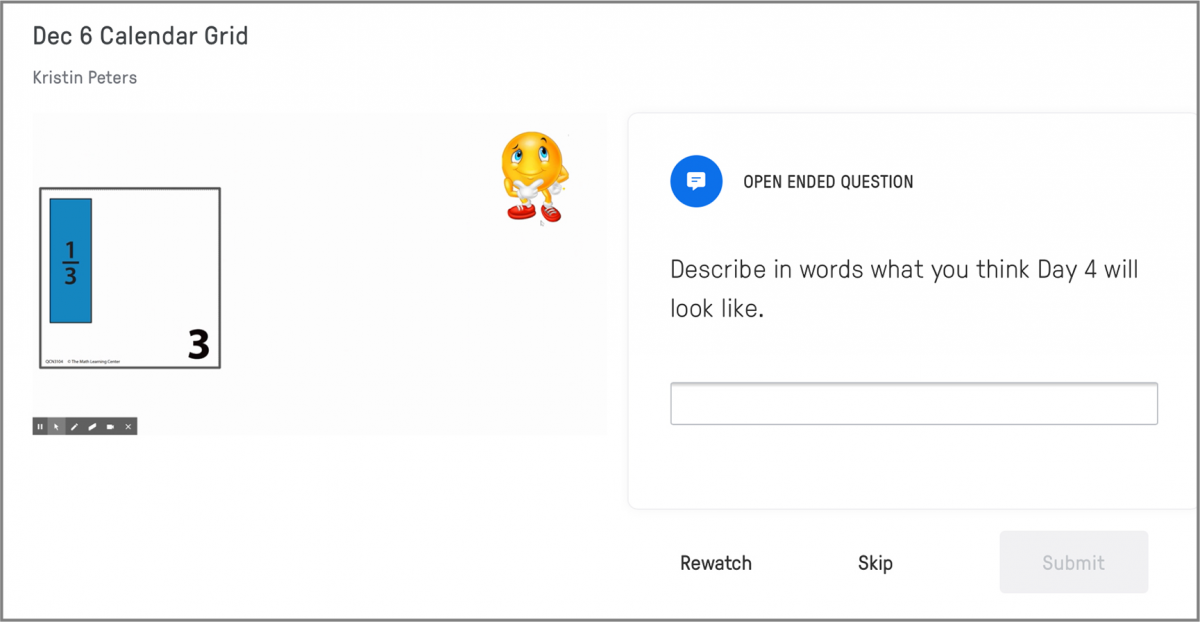
Student-Centered Learning in Asynchronous Environments
In this series of blog posts, we highlight educators in the field who are using remote learning resources intentionally to build classroom community, collaboration, and student sense-making.
In a recent post, Ed Tech Specialist Tod Johnston discusses how educators can leverage digital tools to position students as active partners in their learning. Digital tools are a necessity during this time of remote learning, yet those we offer—and how we offer them to our students—has a profound impact. Tod writes, “We need to remember that the digital learning tools, materials, and tasks we offer must prioritize students as active participants at the center of their learning; not as passive recipients on the outside, merely watching.”
We often hear from Bridges teachers how much they (and their students) are missing their Number Corner time. Indeed, Number Corner is a time students come together as a community to engage and explore mathematical patterns, relationships and structure. With limited time for math this year, some teachers have had to push Number Corner to their asynchronous learning time, a decision that challenges the collaborative and active structure at the heart of this mathematical routine. How—especially in asynchronous environments—can digital learning tools engage students in their own learning?
For Kris Peters, a third grade teacher in Washington, this question has been at the forefront of her mind. She currently has only 10 minutes for Number Corner content four times a week. To support facilitation, Kris records videos that she pushes out to students to launch Number Corner workouts. As the year progressed, Kris found it challenging to gauge what students were gaining from their Number Corner work. The incredible strength of Number Corner came from the student-centered discussions the workouts inspired. “It made me wonder,” Kris shared, “What tools can I use to hear from my students and to see their thinking?”

While she’s tried a few tools, Kris recently discovered the free, basic version of EdPuzzle, a digital resource that allows teachers to deliver videos with an added perk—the ability to capture students’ comprehension and thinking. She shared an example she created for a December Calendar Grid activity. In the video, Kris reminded students of the previous day’s Calendar Grid showing ⅓ and posed the open-ended question, “What do you think Day 4 will look like?” At this point, the video stopped and a question on the sidebar invited responses.
The paused video in EdPuzzle appears on the left and the question Kris posed to her students appears right.
As the video continued, Kris intentionally chose key instructional points to pause, pose a question and invite students to respond. Throughout, Kris asked the questions Bridges educators ask in a classroom in front of students, and EdPuzzle gave a mechanism for hearing back from them, albeit after the fact. “In the fast pace of our limited synchronous instructional time,” Kris shared, “it can be challenging to provide sufficient think time. EdPuzzle allows students to work at their own pace and return to points in the video for clarification as needed.”
Throughout the 6-minute video, Kris offered six pause points that invited students to actively engage. She used multiple choice, open-ended responses, and uploading a photo through Google Slides as ways students could show their work. Responses were recorded and Kris was able to review and check for understanding. Kris acknowledges the limitations of such responses but also speaks of their potential. “It can be a challenge to interpret third grade student thinking based on their written explanations,” she reflects. “Regardless, the questions I'm able to pose are intended to draw attention to mathematical ideas and patterns. Also, I think they send an important message about the kind of thinking we want to be doing.”
You might be wondering, “How else might I use EdPuzzle to enhance Number Corner in an asynchronous environment?” Here are some possibilities:
-
Record videos that show you launching or facilitating the workout. When students see and hear their teacher—even if it’s digitally—they are able to feel more connected to the learning and mathematics.
-
Use EdPuzzle for formative assessment, and to learn about students’ understanding and where they need support. When appropriate, provide students the option of responding by posing an open-ended question such as, “Share with me anything you are unsure or wondering about, or any questions you’d like to pose to the class.” This type of question might help you better understand what students are grappling with mathematically and offers you insight for moving forward.
-
Use EdPuzzle along with MLC’s digital resources, including Digital Display Materials and the tools found in the Resources & Support for 2020-21 section of each grade (login required). You can use these to launch a workout and engage students.
-
Facilitate lessons with free, public MLC apps with the sharing feature that students can use to show their thinking. A link to their work or an image of their work can be pasted or uploaded into EdPuzzle.
No digital tool can replicate the rich experience of learning in person with a community of learners, but as educators like Kris have shown, we can make instructional choices that position students to actively construct their own learning.
